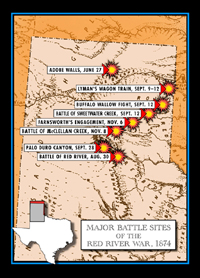
Major battles of the Red River War
Courtesy of the Texas Historical Commission.
|
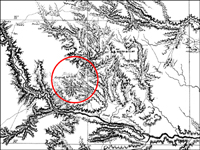
Portion of an 1875 map showing the
general location of the Battle of Red River. Courtesy
of the United States National Archives.
|
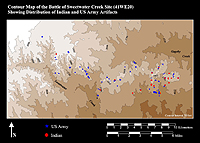
Contour map of the Battle of Sweetwater
Creek site showing the distribution of U.S. Army and
Indian artifacts. Courtesy of the Texas Historical Commission.
|

A Kiowa ledger drawing possibly depicting
the Buffalo Wallow battle. Courtesy Texas Memorial Museum.
|
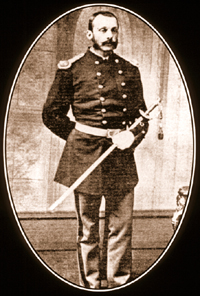
Captain Wyllys Lyman. Courtesy of
Panhandle-Plains Historical Museum.
|
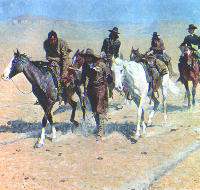
Pony Tracks in the Buffalo Trails by Frederick
Remington. Courtesy of the Amon Carter Museum. |
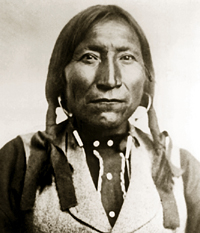
Lone Wolf, Kiowa Chief. Courtesy of Panhandle-Plains Historical
Museum. |
|
Though most of the battles of the Red River
War were brief skirmishes that involved a small number of
combatants and resulted in few casualties, a number of larger
and more significant battles also occurred. These include
the Battle of Red River, Sweetwater Creek, and Palo Duro Canyon.
The battles of Lyman's Wagon Train and Buffalo Wallow also
are notable.
The first battle of the Red River War came on
August 30, 1874, when troops of the Sixth Cavalry and Fifth
Infantry under the command of Colonel Nelson A. Miles caught
up with a large group of Southern Cheyenne near the Prairie
Dog Town Fork of the Red River in what is now southern Armstrong
and northern Briscoe counties, Texas. The military records
describe the daylong Battle of Red River as a running battle
across the rugged canyonlands north and south of the river.
Though the Army soldiers numbered some 650 strong with two
Gatling guns and a 10-pounder Parrott rifle, the Indians were
able to hold them off long enough for the Indian families
to safely escape up Tule Canyon and vanish across the Staked
Plains.
A week earlier, Major William R. Price and companies
C, H, K, and L of the Eighth U.S. Cavalry had left Fort Union,
New Mexico, and headed east toward the Texas Panhandle as
the westernmost column in the campaign against the Southern
Plains Indians. The column consisted of 216 soldiers and included
two mountain howitzers and a large supply train. Crossing
the Texas Panhandle south of the Canadian River, the column
followed the old Fort Smith-Santa Fe Road. On September 4,
Price divided his command, directing Captain Farnsworth to
take H company, all of the wagons, and one howitzer toward
Adobe Walls to establish a supply camp near there.
Major Price took C, K, and L companies and one
howitzer as the main column. On September 12, as the column
moved northeast between Sweetwater Creek and the Dry Fork
of the Washita River, they encountered a large band of Kiowa
and Comanche Indians led by Kiowa chief Lone Wolf. The ensuing
engagement, known as Price's Engagement or the Battle of Sweetwater
Creek, took place along a high ridge north of Sweetwater Creek
in present Wheeler County, Texas.
Though Major Price and the soldiers were not
aware of it while the battle was occurring, a large number
of Indian families apparently were behind the high ridge trying
to evade the troopers and make their escape to the southwest.
The Indian warriors likely were trying to lead the troops
away from the women and children and were trying to keep the
troops occupied long enough to give the families time to escape,
which they did successfully. The running battle lasted some
four hours and covered a distance of about seven miles.
Meanwhile, Miles had decided to establish his
headquarters camp on Red River and send a military escort
under the command of Captain Wyllys Lyman with 36 empty supply
wagons back toward Camp Supply in Indian Territory to restock
the provisions. Lyman's command consisted of 36 infantry,
20 cavalry, and 36 civilian teamsters, of whom only 10 were
armed.
On September 9, the train was returning to the
Red River with supplies when it was attacked by a group of
Kiowa and Comanche warriors at the divide between the Canadian
and Washita rivers. The Indians began firing from long range,
but the defensive maneuvers of the cavalry enabled the train
to move 12 miles farther south until it reached a steep ravine
about a mile north of the Washita River. As the train approached
the river, the Indians began to press the attack and Lyman
ordered the wagons to form into a protective corral for better
defense.
As the train was circling, a group of about
70 warriors attacked from the right and rear of the train
and almost overran the skirmish lines that had been established
by the infantry. The skirmishers held and repulsed the attack
but a sergeant named DeArmond was killed during the assault
and Lieutenant Granville Lewis was severely wounded. One of
the teamsters, a man by the name of Sandford, was mortally
wounded while carrying ammunition to the troops. When the
initial attack failed, the Indians retreated to the surrounding
ridges and began to lay siege to the wagon train. It was later
learned that, in addition to Lone Wolf, several other prominent
chiefs also took part in the battle including Satanta and
Big Tree.
With the onset of darkness, the fighting fell
off, but it was now apparent to Lyman that the Indians intended
to continue their siege for an indefinite period and he ordered
the men to dig rifle pits around the perimeter of the circled
train to afford additional protection for the men. The next
morning the Indians resumed their fire. On the night of September
10, seeing that the situation was desperate, Lyman sent one
of the scouts, W. F. Schmalsle, to Camp Supply to get help.
As he left the wagon train, Schmalsle was chased by the Indians
but he managed to evade them and he arrived at Camp Supply
two days later. On the morning of September 12, the Indians
began to abandon the siege.
Later in the afternoon, a cold rainstorm set
in and continued through the next day. Even though the command
was almost out of supplies, Lyman decided not to try to move
the train in the storm. Several of the horses had been injured
and 22 mules for the wagons had been killed. In the early
morning hours of September 14, Company K arrived from Camp
Supply with medical aid and an ambulance. With the siege broken,
Lyman moved out with the wagons and later that morning joined
Colonel Miles. On the recommendation of Colonel Miles, 13
of the troopers were awarded the Medal of Honor for their
bravery in the fight and Lyman was eventually promoted for
his performance.
On the morning of September 12, 1874 about 125
of the warriors who had laid siege to the Lyman wagon train
decided to move south of the Washita River to join their families.
As the warriors reached a small rise north of Gageby Creek
they ran into a small detachment of six men from Colonel Miles'
command who were riding with dispatches and were charged with
locating Lyman's wagon train. The detachment consisted of
civilian scouts Billy Dixon and Amos Chapman and four soldiers
of the Sixth Cavalry. The ensuing engagement between the warriors
and the six men has come to be known as the Battle of Buffalo
Wallow.
The Indians quickly encircled the couriers,
stranding them with essentially no cover. The little group
of men dismounted and prepared to fight. A Private Smith was
given the horses reins to hold. Within moments of the battle's
outbreak he was shot in the chest and fell to the ground as
the horses stampeded.
After about four hours of the Indians taunting
and firing at them, all of the whites except Dixon had been
wounded. He spotted a small buffalo wallow, a shallow depression
on the plain. Determined to make use of what little cover
there was, Dixon made a run for the wallow, and three of the
other men quickly joined him. Once there, the men began digging
with knives to deepen the depression, throwing the sandy soil
up as a breastwork around the perimeter of the wallow. The
two men who remained outside the wallow were Private Smith
who had been shot first and was believed dead, and Chapman
who had suffered a crippling wound to his leg. After several
attempts, Dixon was able to reach Chapman and carry him back
to the wallow.
As the afternoon wore on, the men began to run
low on ammunition and it was decided that the revolver and
ammunition belt should be retrieved from the body of the dead
Private Smith. One of the soldiers, a Private Rath, ran to
the motionless body and recovered the items, but when he got
back to the wallow he reported that Private Smith was still
alive. Dixon and Rath made their way back to Smith and carried
him back to the wallow, but it was obvious that he would not
survive. "We could see that there was no chance for
him. He was shot through the left lung and when he breathed
the wind sobbed out of his back under the shoulder blade,"
Dixon wrote in his memoirs. Later that night Private Smith
died in his sleep.
By mid-afternoon a storm came up and a heavy
rain began to fall. As miserable as the men were in the buffalo
wallow the storm had an unseen benefit. With the advent of
the inclement weather, the Indians broke off the fight and
disappeared into the night.
The next morning Dixon left the wallow on foot
to try to find help for the wounded men. After a short while,
he encountered the Eighth Cavalry under Major Price's command.
Upon learning of their situation, Colonel Miles had the men
rescued. Although all six men were awarded the Congressional
Medal of Honor, Dixon's and Chapman's were later revoked because
they were not officially enlisted in the Army. In 1989, the
Army Board for Correction of Military Records restored the
medals to Dixon and Chapman.
The critical battle of the Red River War began
as the sun rose on September 28, 1874. At least five Indian
villages had sought protection in the hidden isolation of
Palo Duro Canyon. Then Colonel Ranald S. Mackenzie, in command
of the Fourth Cavalry, charged into the canyon. With their
people scattered, Indian leaders Iron Shirt of the Cheyenne,
Poor Buffalo of the Comanche, and Lone Wolf of the Kiowa could
not mount a united defense and fell back before the onrushing
horsemen. The soldiers captured and burned the villages, including
the Indians' winter food supply. They also captured 1,424
Indian horses that they drove some 20 miles from the scene
of the fight where they killed more than 1,000 of the horses
to prevent them from being retaken by the Indians.
After this battle, with no provisions to see
them through the winter and with no horses, many of the Indians
began to drift back to the reservations. Over the next several
months, the U.S. Army would sweep the remaining Indian holdouts
from the Texas Panhandle and force them onto the reservations.
Thus ended the Indian War on the Southern Plains.
|
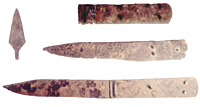
A metal arrow point (left) and knives
used by the Indians at the Battle of Lyman's Wagon train.
Click images to enlarge
|
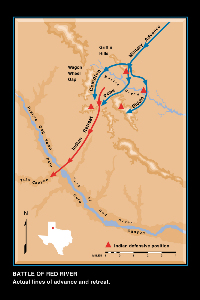
Lines of U.S. Army advance and Indian
retreat at the Battle of Red River site.
|
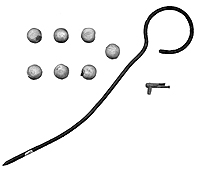
Artifacts from the Battle of Sweetwater
Creek: shot from Howitzer canister; a priming wire;
and a friction primer. Photo courtesy of the Texas Historical
Commission.
|
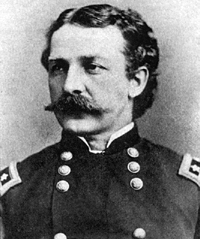
Colonel Nelson A. Miles, Fifth Infantry.
Courtesy of Panhandle-Plains Historical Museum.
|
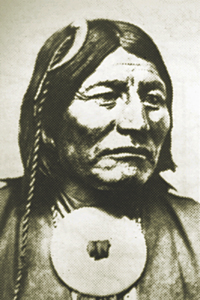
Comanche chief Mow-Way participated
in several of the Red River battles.
|
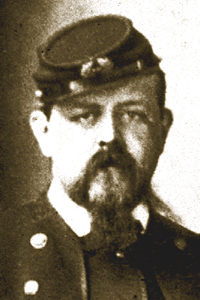
Major William R. Price, Eighth Cavalry.
Courtesy of Paul V. Long.
|
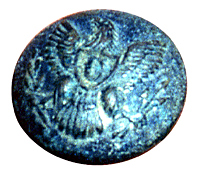
A U.S. Cavalry button.
|
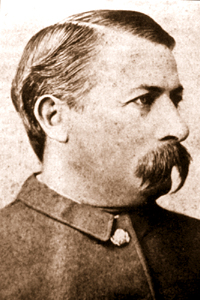
Colonel Ranald S. Mackenzie, Fourth
Cavalry. Courtesy of Panhandle-Plains Historical Museum.
|
|